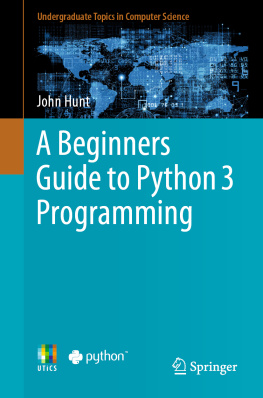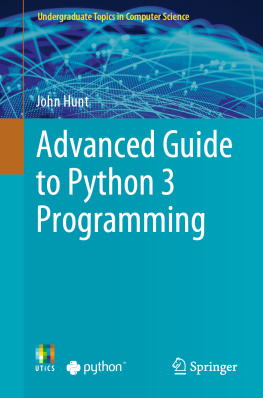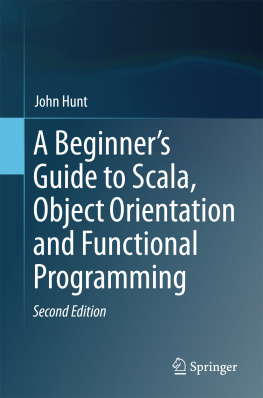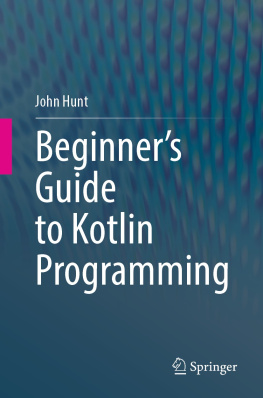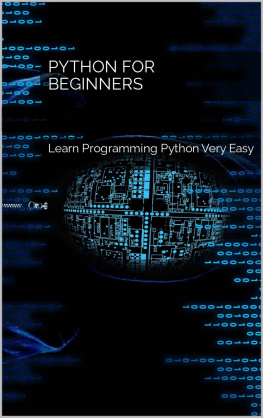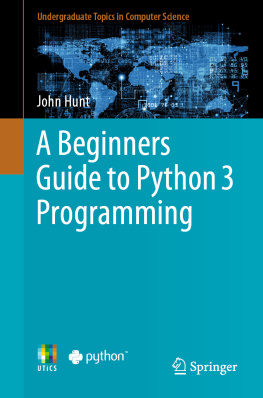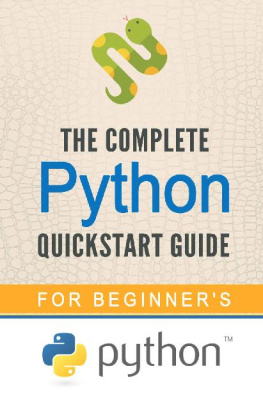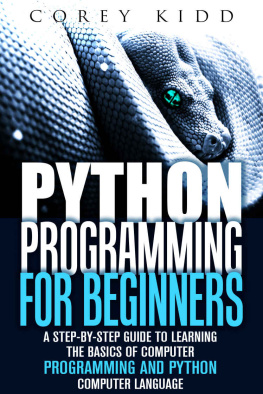John Hunt - A Beginners Guide to Python 3 Programming
Here you can read online John Hunt - A Beginners Guide to Python 3 Programming full text of the book (entire story) in english for free. Download pdf and epub, get meaning, cover and reviews about this ebook. year: 0, publisher: Springer International Publishing, genre: Computer. Description of the work, (preface) as well as reviews are available. Best literature library LitArk.com created for fans of good reading and offers a wide selection of genres:
Romance novel
Science fiction
Adventure
Detective
Science
History
Home and family
Prose
Art
Politics
Computer
Non-fiction
Religion
Business
Children
Humor
Choose a favorite category and find really read worthwhile books. Enjoy immersion in the world of imagination, feel the emotions of the characters or learn something new for yourself, make an fascinating discovery.
A Beginners Guide to Python 3 Programming: summary, description and annotation
We offer to read an annotation, description, summary or preface (depends on what the author of the book "A Beginners Guide to Python 3 Programming" wrote himself). If you haven't found the necessary information about the book — write in the comments, we will try to find it.
A Beginners Guide to Python 3 Programming — read online for free the complete book (whole text) full work
Below is the text of the book, divided by pages. System saving the place of the last page read, allows you to conveniently read the book "A Beginners Guide to Python 3 Programming" online for free, without having to search again every time where you left off. Put a bookmark, and you can go to the page where you finished reading at any time.
Font size:
Interval:
Bookmark:

Undergraduate Topics in Computer Science (UTiCS) delivers high-quality instructional content for undergraduates studying in all areas of computing and information science. From core foundational and theoretical material to final-year topics and applications, UTiCS books take a fresh, concise, and modern approach and are ideal for self-study or for a one- or two-semester course. The texts are all authored by established experts in their fields, reviewed by an international advisory board, and contain numerous examples and problems, many of which include fully worked solutions.
The UTiCS concept relies on high-quality, concise books in softback format, and generally a maximum of 275-300 pages. For undergraduate textbooks that are likely to be longer, more expository, Springer continues to offer the highly regarded Texts in Computer Science series, to which we refer potential authors.
More information about this series at http://www.springer.com/series/7592

This Springer imprint is published by the registered company Springer Nature Switzerland AG
The registered company address is: Gewerbestrasse 11, 6330 Cham, Switzerland
This book was written for, and is dedicated to, my daughter Phoebe and son Adam; I could not be prouder of either of you.
There is currently huge interest in the Python programming language. This is driven by several factors; its use in schools with the Raspberry Pi platform, its ability to be used for DevOps scripts, its use in data science and machine learning and of course the language itself.
There are many books on Python, however, most assume previous programming experience or are focussed on particular aspects of Python use such as data science or machine learning or have a scientific flavor.
The aim of this book is to introduce Python to those with little or very little programming knowledge, and then to take them through to become an experienced Python developer.
As such the earlier parts of the book introduce fundamental concepts such as what avariableis and how afor loopworks. In contrast, the later chapters introduce advanced concepts such as functional programming, object orientation, and exception handling.
In between a wide range of topics are introduced and discussed from a Python point of view including functions, recursion, operators, Python properties, modules and packages, protocols and monkey patching, etc.
After the core elements of Python are established, each new subject area is introduced by way of an introductory chapter presenting the topic in general, providing background on that subject, why it is of importance, etc. These introductions cover Structured Analysis, functional programming, and object orientation.
Some of the key aspects of this book are:
It assumes very little knowledge or experience of Python or programming.
It provides a basic introduction to Python as well as advanced topics such as generators and coroutines.
This book provides extensive coverage of object orientation and the features in Python 3 supporting classes, inheritance, and protocols.
Pythons support for functional programming is also presented.
Following on from introducing the basic ideas behind functional programming, the book presents how advanced functional concepts such as closures, currying, and higher-order functions work in Python.
The book includes exercises at the end of most chapters with online solutions.
There are several case studies spread through the book that broaden understanding of preceding topics.
All code examples (and exercise solutions) are provided online in a GitHub repository.
Each chapter has a brief introduction, the main body of the chapter, followed by a list of (typically) online references that can be used for further reading.
Following this, there is typically anExercisessection that lists one or more exercises that build on the skills you will have learned in that chapter.
Sample solutions to the exercises are available in a GitHub online repository that supports this book.
You can of course just read this book; however, following the examples in this book will ensure that you get as much as possible out of the content.
For this, you will need a computer.
Python is a cross-platform programming language and as such you can use Python on a Windows PC, a Linux box or an Apple Mac, etc. So you are not tied to a particular type of operating system; you can use whatever you have available.
However, you will need to install some software on that computer. At a minimum, you will need Python.
This book focusses on Python 3, so you will need that. Some guidance on this is provided in Chap.on setting up your environment.
Font size:
Interval:
Bookmark:
Similar books «A Beginners Guide to Python 3 Programming»
Look at similar books to A Beginners Guide to Python 3 Programming. We have selected literature similar in name and meaning in the hope of providing readers with more options to find new, interesting, not yet read works.
Discussion, reviews of the book A Beginners Guide to Python 3 Programming and just readers' own opinions. Leave your comments, write what you think about the work, its meaning or the main characters. Specify what exactly you liked and what you didn't like, and why you think so.

